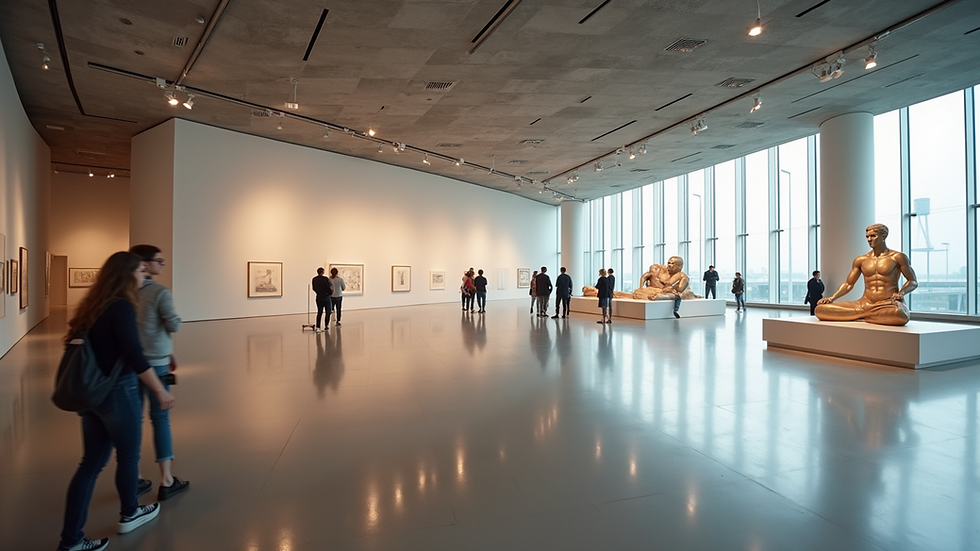The Power of AR Indoor Visual Positioning Tech & Systems
- Shadnam Khan

- Jul 8, 2025
- 4 min read
In recent years, augmented reality (AR) has captured our attention in various industries from gaming to healthcare. One of the most promising applications of AR is the development of indoor positioning technology, which enhances navigation and user experiences in complex environments. This blog post delves into the power of AR indoor positioning tech and how it is revolutionizing the way we interact with our surroundings.
Understanding AR Indoor Positioning Tech
AR indoor positioning tech leverages augmented reality to provide users with accurate location data, enhancing navigation and spatial awareness within buildings. Traditional GPS technology often fails indoors due to weak satellite signals. However, AR utilizes a combination of sensors, maps, and visual markers to pinpoint a user’s exact location. This technology is particularly beneficial in settings like malls, airports, museums, and large office buildings.
Research indicates that 70% of people have difficulty finding their way in unfamiliar buildings. AR indoor positioning systems can simplify navigation by overlaying direction markers and contextual information directly onto the user’s view through their smartphone or AR glasses. Imagine walking through a museum and seeing AR arrows guiding you to your favorite exhibits, or navigating an airport with real-time information displayed in your view – it's a game changer.

Benefits of AR Visual Positioning Systems
The benefits of AR visual positioning systems are profound. Here are some ways they can enhance user experience:
Enhanced Navigation
With AR indoor positioning tech, navigation becomes intuitive. Users can see overlays of maps, directional arrows, and vital information relevant to their location in real-time. For instance, if you're in a large shopping mall, the system can guide you to the nearest store, restroom, or food court.
Improved Engagement
Businesses can utilize AR to foster greater customer engagement. For example, in a retail setting, customers can scan items and receive additional information, virtual discounts, or promotional offers tailored to their real-time location within the store. These engaging experiences drive sales and improve customer satisfaction.
Safety and Emergency Response
In emergencies, AR indoor positioning tech can direct individuals to the nearest exits, first aid stations, or safe areas within a building. This capability is particularly useful in crowded locations or during events, ensuring that the flow of people is efficient and safe.

Real-World Applications of AR Indoor Positioning Tech
To visualize the impact of AR indoor positioning tech, let’s explore some real-world applications:
Retail
AR can transform the retail industry by providing interactive shopping experiences. For example, major brands like IKEA have utilized AR applications that allow customers to visualize how furniture would look in their home before purchasing. In-store navigation can show customers the specific aisle where their selected items are located, making shopping more efficient.
Healthcare
Hospitals and healthcare facilities can use AR for assistance in navigation and emergency protocols. AR can provide hospital staff and patients with visual navigation cues, directing them to departments or rooms smoothly. Moreover, surgeons can benefit from augmented overlays during operations, guiding them with real-time information.
Education
Educational institutions can also greatly benefit from AR visual positioning systems. Museums and educational facilities can create augmented exhibits that enable students to see historical figures or events in context, enhancing the learning experience and promoting engagement.

Challenges and Considerations
While AR indoor positioning tech has immense potential, there are some challenges and considerations to keep in mind:
Accuracy and Reliability
The effectiveness of AR indoor positioning systems hinges on their accuracy. Any errors in mapping can lead to user frustration. Developers must ensure that systems are rigorously tested and provide reliable data.
User Acceptance
For AR technologies to succeed, user acceptance is crucial. Users must understand and trust the technology for it to be effective. Education about privacy concerns and usability can help foster acceptance.
Technological Limitations
AR indoor positioning systems require advanced hardware and software capabilities. Not all users may have access to the necessary devices that support AR experiences, thus limiting the reach of this technology.
Future Outlook of AR Indoor Positioning Tech
The future of AR indoor positioning tech looks bright. As advancements in technology emerge, we can expect greater accuracy and ease of integration into existing systems. Moreover, with increased adoption of smartphones and AR glasses, the accessibility for users will escalate.
Businesses would do well to invest in AR solutions, as they can provide a competitive edge. Enhanced user experiences, increased engagement, and improved safety measures are just the tip of the iceberg. Companies that embrace this technology can position themselves as leaders in customer experience.
The integration of an ar visual positioning system can redefine how we perceive and interact with indoor environments. With further developments in AI and machine learning, the potential applications for AR in indoor positioning are boundless.
Embracing the Revolution
As we continue to witness rapid advancements in technology, AR indoor positioning tech stands out as a remarkable innovation. It brings together a seamless combination of the digital and physical worlds, providing new opportunities for interaction and engagement.
Exploring and implementing AR solutions can lead to substantial benefits for businesses and users alike, paving the way for smarter cities and enhanced public spaces. The key lies in understanding these technologies and embracing their potential to transform the way we navigate, shop, and learn.
In summary, by harnessing the power of AR indoor positioning tech, we can create experiences that are not only more efficient but also more engaging, interactive, and enjoyable. The future is bright, and the possibilities are endless.




Comments